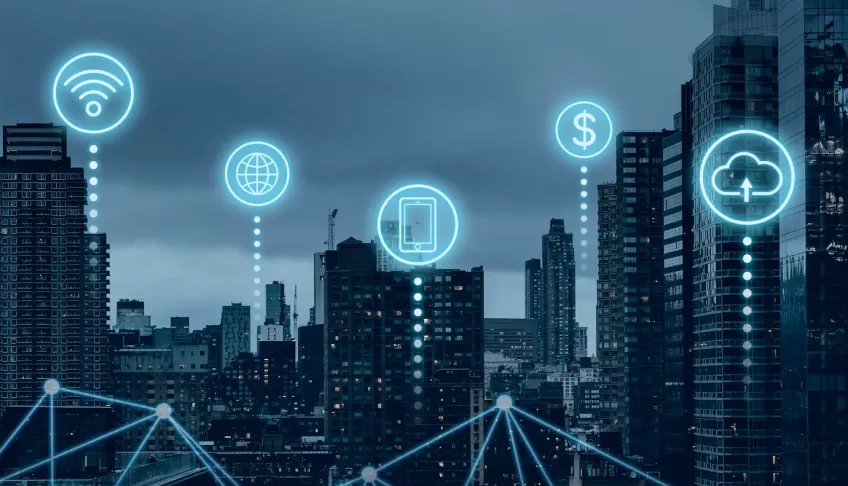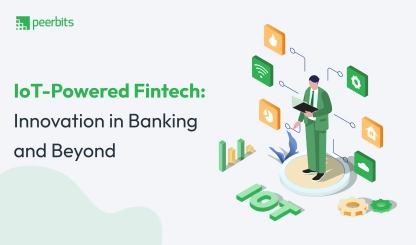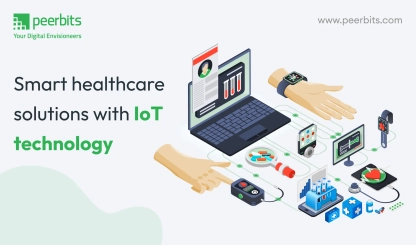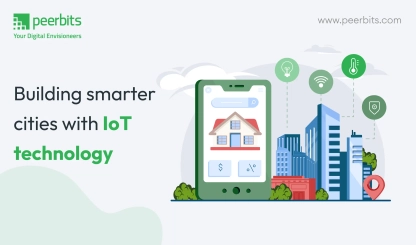Nowadays, smartphones, smartwatches, smart glasses: intelligent, data-driven technology surrounds us and touches every aspect of human life.
These devices are a result of IoT technologies, where the tech can interact with their human owners and also with each other.
Devices like Fitbit Flex use Bluetooth or Wi-Fi to sync health data with smartphones. Likewise, the Apple Watch now supports answering calls and texting directly from your wrist.
Smart gadgets kicked off the ‘smart’ revolution, simplifying tasks and boosting productivity in daily work. An IoT app development company develops applications that support communication between devices, creating a connected system that saves time and improves workflows.
From smart homes to automobiles, these devices are transforming how people approach their daily tasks. Their true potential lies in the connections that improve workflows and drive better results. Connected devices and their applications are paving the way for smarter, more efficient offices.
IoT in the workplace: Creating smarter, more connected environments
Are you already carrying a portable office with you? Think about the device you rely on to check emails, edit documents, or access the Project Management System.
Yes, it’s your smartphone.
It performs many tasks typically done at the office. But smart office technology has the potential to go even further. Imagine navigating to your meeting location with ease or managing warehouse inventory directly from your smartwatch.
This connects directly to IoT by showcasing how everyday devices can evolve into an interconnected network. IoT lets these devices share data and work together, creating smarter workflows and enhancing productivity within office environments.
Utilizing custom app development services, companies can customize applications to specific needs, improving integration and delivering a more personalized experience for users across various devices.
According to the IMARC Group, the global smart office market is projected to grow to USD 122.6 billion by 2032, with a CAGR of 11.5% from 2024 to 2032. The increasing adoption of IoT services and the rise in smart fuels this expansion.
Boosting organizational accuracy through connected intelligence
The smart office technology lets an entire organization simultaneously answer a client question or give reaction to a proposed idea. This is the idea of collective intelligence.
When multiple people share their perspectives on the same tasks, it is often believed that errors are less likely to occur. This collaboration could improve an organization's accuracy and efficiency.
Chatter, for example, allows a help desk executive to seek answer to a client’s question from a person in the concerned department without going through the hassle of scrolling through the documentation.
An employee in your office at the time of the need can link to the right personnel, at the right time, no matter where he or she is.
How smart technology optimizes time and resources in offices

Remember the time of fall when it’s neither too hot or cold to decide the optimum room temperature everybody will feel comfortable working under.
A Smart thermostat with ambient temperature sensors interfaced with the temperature controller can iron out the issue. In the end, it also saves energy.
In a connected workplace, there is better transparency of work. Team Leaders can learn the status of a project in seconds without having to call a team meeting.
This saves everybody’s time and can do a miracle in an agile development environment.
Maximizing workplace productivity with IoT innovations
Devices continue to connect us, making us part of something much bigger than just a mere office.
It’s time to start thinking advantageously about how to carry your company and your office organized for an unparalleled grade of superiority and intelligence.
IoT can bring your business, your workplace, and your work into the future, today.
Boosting operational efficiency with self-monitoring smart devices

The biggest problem with product installations is what if they fail to function as expected?
This isn’t the case with smart devices that can monitor the condition of each component and notify a technician on his smart portable device whenever one component fails in the product.
These products, with so much of the data fetch and report, can with data mining return unprecedented insights.
Smart bracelets are now used as visitor tickets and payment instruments at Disneyland. These devices track visitors' spending habits, movement, and wait times at rides. Park managers use this data to control traffic flow, while marketers use it to create targeted campaigns.
A similar integration of technology is seen with the iconic Dilluminati tours, where lighting is added to their shows to enhance aesthetics and create a more immersive experience.
This highlights how smart devices and data-driven insights can revolutionize not just operations but also customer experiences.
Transforming employee experiences with adaptive smart desks
Desks in an office are a common sight. It’s prime function in the office haven’t changed for a long period.
With IoT you might see smart furniture which would include smart desks in your office.
These desks would have the capability to understand the user’s preferences and adjust to it automatically.
These desks would increase the efficiency of an employee as the minor tasks can be completed quickly with its help.
Bridging remote and on-site teams for increased productivity
With the changes brought by the pandemic, the hybrid workplace is gaining popularity. It has increased the need for better support and collaboration across teams. With this technology, professionals can communicate with on-site colleagues, and augmented reality offers true-life experiences.
Benefits of IoT in the workplace
Implementing IoT in the workplace can drive both productivity and efficiency by connecting devices and data to streamline processes. This interconnected system of devices helps automate tasks, optimize resources, and reduce operational costs.
Here are some practical ways IoT benefits workplaces:
- Automated monitoring: IoT devices can monitor equipment health, energy consumption, and inventory levels, cutting down on manual tasks.
- Enhanced space utilization: Smart sensors analyse how office space is used, helping to create more effective layouts and reduce unused areas.
- Boosted employee experience: Automations for resource booking or work environment adjustments add convenience and improve workplace satisfaction.
The benefits of IoT are shaping entire urban ecosystems, with connected solutions driving innovation and growth. Explore how IoT is revolutionizing urban development and fostering smarter cities.
Challenges of IoT in the Workplace
While IoT brings significant advantages, integrating it into the workplace comes with challenges. These include managing large volumes of data, ensuring security, and dealing with technical complexities.
Let’s look at the key challenges:
| Challenges | Solutions |
|---|---|
| Data security concerns | Implement strong encryption methods, regular software updates, and access controls to safeguard data. |
| Complex system integration | Work with experienced vendors and ensure proper planning and testing before full implementation. |
| High data volume | Utilize advanced data analytics tools and cloud storage solutions to manage and process large amounts of data efficiently. |
| Lack of skilled workforce | Provide training programs and workshops to ensure staff are well-prepared to handle IoT technologies. |
| High implementation cost | Start with scalable IoT solutions and gradually expand as needed, ensuring a phased approach to minimize upfront costs. |
Integrating IoT in the workplace brings challenges such as data security, device compatibility, and managing extensive data streams. For more on securing IoT systems, check out our blog on IoT security challenges.
Best IoT practices for your workplace
Adopting IoT effectively requires a well-planned approach to ensure it meets workplace needs while minimizing potential issues. The following best practices can help maximize IoT success:
- Define clear objectives: Establish specific goals for IoT use, like improving efficiency or enhancing resource management, to guide implementation.
- Prioritize security: Use strong data encryption, regular device updates, and access controls to protect against security risks.
- Invest in training: Equip staff with the necessary skills and knowledge to operate IoT devices confidently and securely. Plan for future growth: Choose IoT solutions that can expand with your company, ensuring they stay valuable as your business grows.
Implementing effective IoT practices requires a strong foundation in testing and quality assurance. Explore strategies for building a resilient testing framework for IoT systems in this resource.
Applications
IoT enabled workplace solution has various applications:
| Components | Function |
|---|---|
| Security Cameras | Networked cameras can send streaming video straight to a mobile device. |
| Sensitive planters | Wireless monitors text your smartphone when your plants need water,fertilizer, or sunlight. |
| Lighting | Set brightness of workplace lighting conditions with a remote control or presets. |
| Doorbell | See and talk to delivery drivers or other visitors via your smartphone-even if you're not at the office. |
| Locks | Never worry about losing your keys or rushing to change your locks when an employee leaves abruptly. Instead, just update your key codes on your smartphone. |
| Climate control | Program your office's thermostats for the nights and weekends, so you're not air-conditioning or heating empty cubicles. |
| Water gauges | Check the water levels on your fish tank-or get notified of leaks and floods in your office. |
| Window shades | Reduce energy costs by programming your shades to move with the sun. |
| Motion sensors | Program your lights to turn on and off when people enter and leave, and have the system alert you when someone's entered the office. |
| Conference room reservations | As soon as you walk into a meeting room, Robin's software will recognize your phone and book the room on the spot. |
Workplace IoT security concerns
Components modernized with IoT in workplaces bring great potential, but they also raise significant security concerns. The usage of IoT devices in office spaces can lead to vulnerabilities that need careful attention.
Let’s explore these concerns in detail and understand why it is important to address them as we move forward.
If you let the usage of IoT devices in the offices, then your employees must be aware of its security features.
These devices usually consist of cameras and microphones. Often, these features are basic and can be easily hacked, which raises the red flag.
It won’t be a tough job for someone to orchestrate industrial espionage through any of these devices.
Even in the case, someone doesn’t spy on you on purpose, would you risk discussing your big decisions such as big deals or layoffs in the presence of a device that records all the data incessantly?
It would be a massive headache as far as the privacy of the employees is concerned.

Conclusion
IoT in the workplace brings many benefits, but security concerns still cause some hesitation. Many businesses are unsure if the advantages outweigh the risks. As security features continue to improve, more companies are likely to embrace smart office systems.
IoT-powered offices offer more than just temperature control or lighting. They bring faster, more efficient, and secure operations that can lead to a better return on investment.
Ultimately, the decision to adopt IoT is yours, but the potential benefits could significantly improve your business operations and overall success.
If you’re interested in smart office systems, minimizing security risks should be a priority. One way to achieve this is to hire dedicated software development team that specializes in creating customized applications to meet your specific needs.
With the expertise of a skilled team, you can build a secure, efficient app tailored to your office's requirements, ensuring both functionality and data protection.
FAQs
Challenges like system integration, security risks, and device management can be addressed by working with experienced IoT developers and using strong security protocols.
The main concerns include data breaches, unauthorized access, and weak encryption. Unsecured IoT devices can become entry points for cyberattacks.
IoT integrates security systems such as cameras, access control, and alerts, providing better protection and reducing security risks.
Cloud technology allows remote control, real-time data sharing, and centralized management, improving the efficiency of IoT systems.
IoT reduces costs through automation, predictive maintenance, and energy savings, offering long-term financial benefits.
Yes, IoT can be adjusted to fit the specific needs of industries like healthcare, finance, and education, improving overall functionality.








